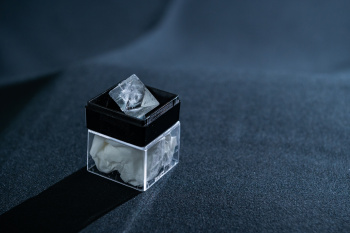Posted by Oliphant Science Awards
on 27/04/2022

by Ian McMahon
The substance, alum, is almost the principal factor for achieving some degree of success in growing good crystals.
The percentage purity of the alum needs to be high so that contaminant particles do not disrupt the proper crystal formation. The source of alum therefore must be considered before anything else.
Chemical supply companies such as Omega Scientific, Ace Chemical Co and Aim Scientific all have high purity alum available to purchase. The minimum quantity is 500g and the cost makes it difficult for smaller schools to afford if involved for only one year.
Don't forget you need at least 10 weeks to grow a good crystal. Find out more in the 2022 OSA Information Booklet here.
If your school has connections with a neighbourhood secondary school, they may be able to supply some to you.
For students who wish to grow crystals at home, obtaining good alum is the issue – hopefully your school will support you. For home-schooled students, it may be best to contact one of the chemical suppliers direct to see what they can do for you. They know of this competition and may be able to supply a smaller quantity thus less cost to you.
Amounts of alum that are can be purchased from hardware stores and garden centres are less pure sometimes tainted with insoluble particles as well as other soluble compounds. Some work will need to be done to have this alum ready for crystal growing.
This will involve dissolving a small quantity of alum in hot water e.g 1 teaspoon per half a glass of hot water and keep adding until some alum remains undissolved. If you have measuring devices, then 15g per 25 mL of hot water is a fair ratio
Here is the second factor in crystal growing – the quality of water. Tap water is no substitute for distilled water or deionized water. Outside of schools, distilled water can be purchased from supermarkets.
It is important that students use the quantities given above. Using too much solid will prevent all the alum from fully dissolving and a powdered, rather than a crystalline product will form. Using too much water means that on cooling, no crystals will appear, since the solution is still unsaturated.
Students should understand that this method works because alum dissolves in water whilst most of the foreign matter is insoluble. They should also realise that the alum eventually crystallises out since it is far less soluble in cold water than in hot.
One method to improve the purity of the alum can be noted in the diagram below. If the source of alum is of lesser quality, then filtering a hot alum solution will provide the saturated solution left behind in the evaporating dish. This can allow students to ‘grow’ crystals from the saturated solution left behind in the evaporating dish .
Seed crystals can be obtained from the cooled saturated solution.
Traditionally, this is carried out by suspending crystals from a length of cotton, but equally good results are obtained by choosing a well-formed crystal and placing it in some of the filtered saturated solution (bottom grown). Dust-free conditions are essential.
The third principal factor is temperature control (to be covered in the next blog edition)
The following diagram is provided courtesy of the Royal Society of Chemistry

In this Section
Archive
- December 2025
- November 2025
- October 2025
- September 2025
- August 2025
- July 2025
- June 2025
- May 2025
- April 2025
- March 2025
- February 2025
- January 2025
- December 2024
- November 2024
- October 2024
- September 2024
- August 2024
- July 2024
- June 2024
- May 2024
- April 2024
- March 2024
- February 2024
- December 2023
- November 2023
- October 2023
- September 2023
- July 2023
- June 2023
- May 2023
- April 2023
- March 2023
- February 2023
- January 2023
- December 2022
- November 2022
- October 2022
- August 2022
- July 2022
- June 2022
- May 2022
- April 2022
- March 2022
- February 2022
- January 2022
- December 2021
- November 2021
- October 2021
- September 2021
- August 2021
- July 2021
- June 2021
- May 2021
- April 2021
- March 2021
- February 2021
- January 2021
- December 2020
- November 2020
- October 2020
- September 2020
- August 2020
- July 2020
- June 2020
- May 2020
- April 2020
- October 2018
- September 2018
- August 2018
- July 2018

